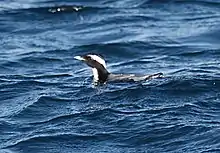Synthliboramphus
Synthliboramphus is a small genus of seabirds in the auk family from the North Pacific. The genus name Synthliboramphus is from Ancient Greek sunthlibo, "to compress", and rhamphos, "bill". The English name "Murrelet" is a diminutive of "murre", a word of uncertain origins, but which may imitate the call of the common guillemot.[1][2]
| Synthliboramphus | |
|---|---|
 | |
| Ancient murrelet (Synthliboramphus antiquus) | |
| Scientific classification | |
| Domain: | Eukaryota |
| Kingdom: | Animalia |
| Phylum: | Chordata |
| Clade: | Dinosauria |
| Class: | Aves |
| Order: | Charadriiformes |
| Family: | Alcidae |
| Genus: | Synthliboramphus Brandt, JF, 1837 |
| Type species | |
| Alca antiqua Gmelin, JF, 1789 | |
| Species | |
|
S. hypoleucus | |
| Synonyms | |
|
Endomychura | |
Taxonomy
The genus Synthliboramphus was introduced in 1837 by the German born naturalist Johann Friedrich von Brandt.[3] The type genus was subsequently designated by George Robert Gray as the ancient murrelet.[4][5] The genus name combines Ancient Greek sunthlibō meaning "to compress" with rhamphos meaning "bill".[6]
The genus contains five species:[7]
| Image | Scientific name | Common name | Distribution |
|---|---|---|---|
 | Synthliboramphus hypoleucus | Guadalupe murrelet | the California Current system in the Pacific Ocean. |
 | Synthliboramphus scrippsi | Scripps's murrelet | California Current system in the Pacific Ocean |
 | Synthliboramphus craveri | Craveri's murrelet | the Pacific Ocean and the Gulf of California off the Baja peninsula of Mexico |
 | Synthliboramphus antiquus | Ancient murrelet | northeast Asia, Aleutian Islands to western Canada, Commander Islands (eastern Russia). |
 | Synthliboramphus wumizusume | Japanese murrelet | Japan and southern Korea. |
The first two species were formally considered conspecific,[8] and are sometimes separated in the genus Endomychura.
Fossil remains of two prehistoric species are known: an undescribed Synthliboramphus sp. from the Late Miocene or Early Pliocene (c. 5 mya) of Cedros Island, Mexico, and Synthliboramphus rineyi from the Late Pliocene (around 3.5-2 mya) San Diego Formation of the southwestern USA.
These birds breed in colonies, their eggs being laid directly amongst tree roots or in rock crevices. They are nocturnal on the breeding grounds, presumably to reduce predation, and for the same reason the precocial young are never fed at the nest, being taken to sea a couple of days after hatching. The parents call to the young from out at sea, and the chicks swim towards the adults who keep moving further out throughout the night.
Synthliboramphus species disperse out to sea after breeding, with northern species migrating further south.
Synthliboramphus auks are small, with mainly black upper parts and white the short wings. These birds forage for food like other auks, by swimming underwater. They mainly eat fish, also some crustaceans and other small invertebrates.
References
- "Murrelet". Oxford English Dictionary (Online ed.). Oxford University Press. (Subscription or participating institution membership required.)
- "Murre". Oxford English Dictionary (Online ed.). Oxford University Press. (Subscription or participating institution membership required.)
- von Brandt, Johann Friedrich (1837). "Rapport sur une monographie de la famille des Alcadées". Bulletin Scientifique publié par L'Académie Impériale des Sciences de Saint Pétersbourg (in French). 2 (22). cols. 344-349 [347].
- Gray, George Robert (1840). A List of the Genera of Birds : with an Indication of the Typical Species of Each Genus. London: R. and J.E. Taylor. p. 77.
- Peters, James Lee, ed. (1934). Check-List of Birds of the World. Vol. 2. Cambridge, Massachusetts: Harvard University Press. p. 356.
- Jobling, James A. (2010). The Helm Dictionary of Scientific Bird Names. London: Christopher Helm. p. 376. ISBN 978-1-4081-2501-4.
- Gill, Frank; Donsker, David; Rasmussen, Pamela, eds. (August 2022). "Noddies, gulls, terns, skimmers, skuas, auks". IOC World Bird List Version 12.2. International Ornithologists' Union. Retrieved 10 November 2022.
- Chesser, R.T.; Banks, R.C.; Barker, F.K.; Cicero, C.; Dunn, J.L.; Kratter, A.W.; Lovette, I.J.; Rasmussen, P.C.; Remsen, J.V.J.; Rising, J.D.; Stotz, D.F.; Winker, K. (2012). "Fifty-Third Supplement to the American Ornithologists' Union Check-List of North American Birds". The Auk. 129 (3): 573–588. doi:10.1525/auk.2012.129.3.573.